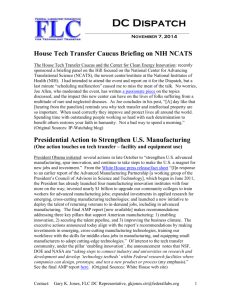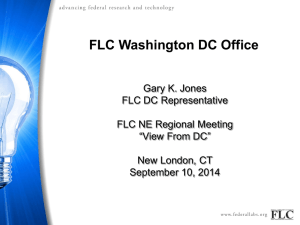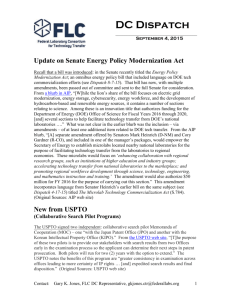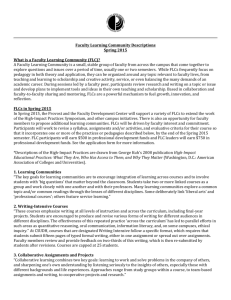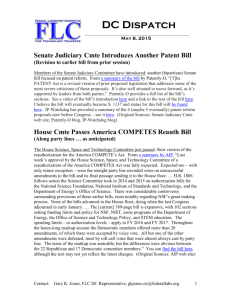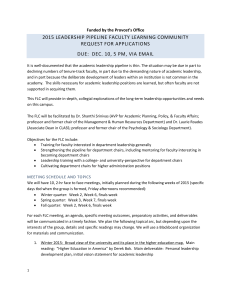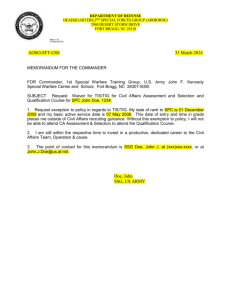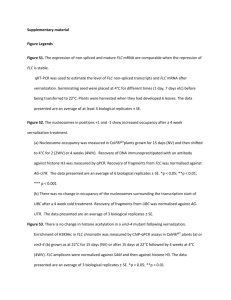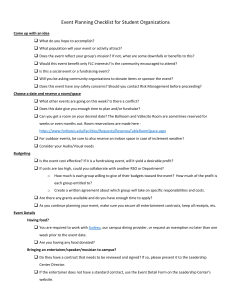July 24 - Federal Laboratory Consortium for Technology Transfer
advertisement
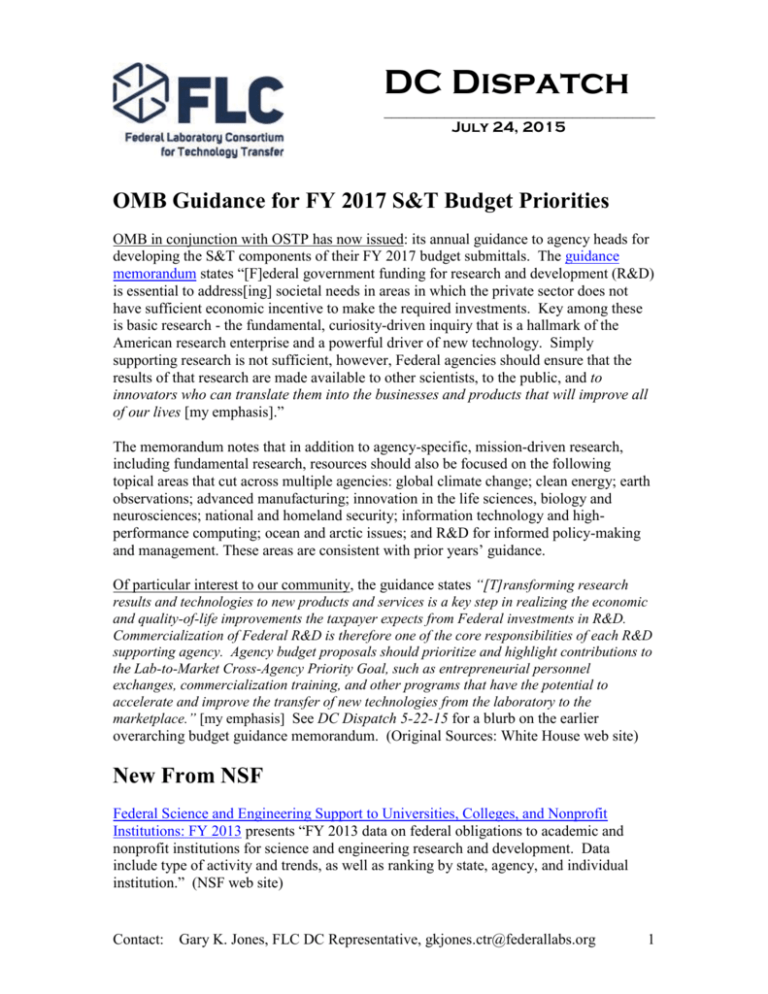
DC Dispatch ____________________________________ July 24, 2015 OMB Guidance for FY 2017 S&T Budget Priorities OMB in conjunction with OSTP has now issued: its annual guidance to agency heads for developing the S&T components of their FY 2017 budget submittals. The guidance memorandum states “[F]ederal government funding for research and development (R&D) is essential to address[ing] societal needs in areas in which the private sector does not have sufficient economic incentive to make the required investments. Key among these is basic research - the fundamental, curiosity-driven inquiry that is a hallmark of the American research enterprise and a powerful driver of new technology. Simply supporting research is not sufficient, however, Federal agencies should ensure that the results of that research are made available to other scientists, to the public, and to innovators who can translate them into the businesses and products that will improve all of our lives [my emphasis].” The memorandum notes that in addition to agency-specific, mission-driven research, including fundamental research, resources should also be focused on the following topical areas that cut across multiple agencies: global climate change; clean energy; earth observations; advanced manufacturing; innovation in the life sciences, biology and neurosciences; national and homeland security; information technology and highperformance computing; ocean and arctic issues; and R&D for informed policy-making and management. These areas are consistent with prior years’ guidance. Of particular interest to our community, the guidance states “[T]ransforming research results and technologies to new products and services is a key step in realizing the economic and quality-of-life improvements the taxpayer expects from Federal investments in R&D. Commercialization of Federal R&D is therefore one of the core responsibilities of each R&D supporting agency. Agency budget proposals should prioritize and highlight contributions to the Lab-to-Market Cross-Agency Priority Goal, such as entrepreneurial personnel exchanges, commercialization training, and other programs that have the potential to accelerate and improve the transfer of new technologies from the laboratory to the marketplace.” [my emphasis] See DC Dispatch 5-22-15 for a blurb on the earlier overarching budget guidance memorandum. (Original Sources: White House web site) New From NSF Federal Science and Engineering Support to Universities, Colleges, and Nonprofit Institutions: FY 2013 presents “FY 2013 data on federal obligations to academic and nonprofit institutions for science and engineering research and development. Data include type of activity and trends, as well as ranking by state, agency, and individual institution.” (NSF web site) Contact: Gary K. Jones, FLC DC Representative, gkjones.ctr@federallabs.org 1 FLCBus Called Out in NSTC Working Group Report (Oops – How Did I Miss This; From Fall 2014) In September 2014, the Interagency Working Group on Federal Security Laboratories and Infrastructure: (under the NSTC’s Committee on Homeland and National Security), released a report titled, Recommended Goals to Modernize and Revitalize Federal Security Laboratory Facilities and Infrastructure. On page 9, under the title Goal #3: Create an Online Catalog of National Security F&I to Effectively Communicate the Value and Opportunities Associated with Federal Resources and Capabilities, the report notes, “[T]he Working Group recommends developing the catalog in a discipline- and laboratory-agnostic manner and in partnership with managers of existing resources, such as those managed by OMB and the Federal Laboratory Consortium (FLC). • OMB, through the Federal Real Property Council (FRPC), maintains a Federal real property database that classifies F&I at Federal laboratories using unique identifiers. However, the database is not comprehensive since it captures the dominant use rather than all capabilities the F&I supports. • FLC maintains an online list of 314 F&I resources and capabilities across Federal laboratories. The FLC list is based on web-search data and a voluntary data call, and it is incomplete and inconsistent in its current state. The new catalog should employ identifiers used by the FLC and OMB to enable consistent tracking of assets across existing databases.” NSTC sits within the Office of Science and Technology Policy and “is the principal means within the executive branch to coordinate science and technology policy across the diverse entities that make up the Federal research and development enterprise. Chaired by the President, the membership of the NSTC is made up of the Vice President, the Director of the Office of Science and Technology Policy, Cabinet Secretaries and Agency Heads with significant science and technology responsibilities, and other White House officials. A primary objective of the NSTC is the establishment of clear national goals for Federal science and technology investments in a broad array of areas spanning virtually all the mission areas of the executive branch.” (Original Sources: White House web site) OSTP Seeks Participants in ‘Challenge Prize’ Event This fall the Federal government will celebrate: “the fifth anniversary of Challenge.gov, a one-stop shop that has prompted tens of thousands of individuals, including engaged citizens and entrepreneurs, to participate in more than 400 public-sector prize competitions with more than $72 million in prizes.” From the White House blog, “[this event will] highlight the role that prizes play in solving critical national and global issues. The event will showcase public- and private-sector relevant commitments from Federal, state, and local agencies, companies, foundations, universities, and non-profits. Individuals and organizations interested in participating in this event or making commitments should send us a note at challenges@ostp.gov by August 28, 2015 (my emphasis).” (Original Sources: White House blog) Contact: Gary K. Jones, FLC DC Representative, gkjones.ctr@federallabs.org 2 DOE in the News Hosts 2nd National Lab Day on the Hill DOE recently hosted: the second in a series of five planned Congressional events designed to “highlight the national laboratory system as a cornerstone of the U.S. innovation ecosystem.” From a summary by AIP, “the event highlighted the national labs’ contributions toward the development of a new, modernized energy infrastructure for the nation. It featured remarks from high-level DOE officials, Members of Congress, and national lab directors, and exhibits in four DOE systems areas related to energy infrastructure: electric grid modernization; subsurface science; sustainable transportation; and integrated energy systems. … For the next three National Lab Days on Capitol Hill, which will be held at six-month intervals, the DOE will highlight other areas of its mission: national security, basic science research, and then environmental management.” (Original Sources: AIP web site) Pilot a Small Business Vouchers Program DOE recently announced: a Small Business Vouchers pilot, “a public-private partnership connecting small businesses with DOE scientists, engineers, and facilities.” From a summary by SSTI, “[T]hrough the program’s funding, labs will provide vouchers, ranging from $50,000 to $300,000, to more than 100 small businesses in an effort to help leverage the expertise and tools at the labs for product testing, validation, introduction, and expansion. The Energy Department will also launch the Small Business Central Assistance Platform, a web-based tool to assist in communication between small businesses and DOE Labs and facilitate the vouchers. The five Energy Department National Laboratories selected for the pilot are: Oak Ridge National Laboratory ($5.6 million); National Renewable Energy Laboratory ($4.9 million); Lawrence Berkeley National Laboratory ($4.2 million); Sandia National Laboratories ($2.8 million); and, Pacific Northwest National Laboratory ($2.7 million).” See the DOE press release for more details. (Original Sources: SSTI web site, DOE web site) AAAS Opens 2015 Leadership Seminar Nominations AAAS has announced: that its 2015 Leadership Seminar in Science and Technology Policy, scheduled for November 16-20 is open for nominations. From the website, “[This seminar] is a ‘crash course’ in science and technology (S&T) policy, designed for those who need to know how S&T policy works. … Space is limited to only 30 to 35 participants--the small group setting provides an ideal opportunity to learn about the challenges and solutions of S&T policy from the experts. … [Those who should consider attending include] anyone who needs or wants to know how S&T policy works at both macro and micro levels — scientists and engineers, administrators, and managers in any sector (industry, academia, or government). Specifically, this includes federal grant recipients and managers, industrial R&D managers, agency program managers, association officials, public affairs or government affairs specialists, science diplomats, and others.” (Original Sources: AAAS web site) Contact: Gary K. Jones, FLC DC Representative, gkjones.ctr@federallabs.org 3 Update on Innovation Act (HR 9) Leadership in the House of Representatives has reportedly removed: Rep. Goodlatte’s Innovation Act (H.R. 9) “from House Floor consideration for this summer – indicating that the bill is not yet ready for a consensus vote.” From Patently-O, “[S]ome amount of opposition had been building within Congress, including a joint press conference [July 14] that included U.S. Representatives John Conyers (D-Mich.), Thomas Massie (R-Ky.), Bill Foster (D-Ill.), and Scott Peters (D-Calif.) as well as Senators Chris Coons (DDel.) and David Vitter. In their press release, the group wrote that ‘H.R. 9 is strongly opposed by inventors, small businesses, venture capitalists, startup communities, and manufacturing, technology, and life sciences companies.’ A compromise bill has some chance this fall and we can expect more aggressive PR campaigns showing the woes of patent trolls as well as the benefits of patent-driven innovation.” See related articles in US News and World Report, and IP-Watchdog. (Original Sources: Patently-O blog, US News web site, IP-Watchdog blog) Call to Action for Federal Commitment to Innovation A growing list of organizations and institutions from across the country has signed: a new “call to action to restore the federal government’s commitment to scientific research and discovery.” From a blurb from SSTI, “Innovation: An American Imperative provides seven areas of focus for Congressional action, including to end the sequestration spending caps on research funding, make the federal R&D tax credit permanent, fund training and incentives for STEM educators, reform U.S. visa policy, streamlining research regulations, reaffirm merit-base peer review and stimulate advanced manufacturing.” See related blurb on this topic by AIP. (Original Sources: SSTI web site, amacad web site, AIP web site) ---------------------------------------------------------------------------------------------- Note: The DC Dispatch is a periodic update of selected items of interest to the FLC and technology transfer community -- i.e., current legislation, trends, reports, policy and other developments potentially affecting technology transfer or related activities -- designed to keep the community informed of relevant issues on a timely basis. Information is gleaned directly from a variety of sources (newsletters, email alerts, web sites, direct participation at events from the FLC DC Representative’s office, etc.) -- with original sources, contacts and links provided. Contact: Gary K. Jones, FLC DC Representative, gkjones.ctr@federallabs.org 4
